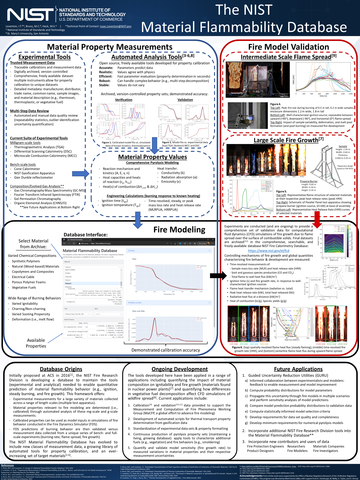Isaac Leventon (Fed)
Fire Protection Engineer
Isaac Leventon is an alumni of the University of Maryland (UMD), where he completed his BS, MS, and PhD with the Department of Fire Protection Engineering. He currently leads the Engineered Fire Safe Products (EFSP) Project at NIST, which is focused on developing a database (the NIST Material Flammability Database) to maintain the tools (experimental and analytical) needed to enable quantitative prediction of material flammability behavior (e.g., ignition, steady burning, and fire growth). Initially proposed in 2016[1], this framework offers:
- Experimental measurements for a large variety of materials collected across a range of length scales (multiple test apparatus).
- Material properties relevant to fire modeling are determined (i.e., calibrated) through automated analysis of these mg-scale and g-scale measurements.
- Calibrated properties can be used as model inputs in simulations of fire behavior conducted in the Fire Dynamics Simulator (FDS).
- FDS predictions of burning behavior are then validated versus measurement data collected from a unique series of bench- and full-scale experiments[10] (burning rate, flame spread, fire growth).
Isaac also maintains a strong interest in developing student involvement and interest in science and engineering, mentoring and teaching at both the high school and university levels and leading fire science demonstrations for elementary, middle, and high school classes. He developed the pre-college program, An Introduction to Math and Physics through Fire Dynamics, which he led at UMD for three years, and he recently taught several classes - fire dynamics, structural fire protection engineering, enclosure fire modeling, and the graduate fire dynamics laboratory - as an adjunct lecturer with the UMD Fire Protection Engineering department and as part of a new program led by UMD in Tel Aviv, Israel.
In his free time, Isaac volunteers with the USA Warriors and MYHA Hockey Programs and with the Gaithersburg Washington Grove Volunteer Fire Department. Each winter, in collaboration with UMD, Isaac also coordinates an annual Christmas Tree fire safety demonstration for local media and a friendly international competition for students, faculty, researchers, and engineers from fire safety programs around the world to predict the burning behavior of these fires.
Please visit Google Scholar for a full list of publications.

Current EFSP Research applications include:
- Calibration[2] and validation[3,4] data provided to support the Measurement and Computation of Fire Phenomena Working Group (MaCFP, a global effort to advance fire modeling)
- Development of automated scripts for material property calibration (i.e., reaction mechanisms/associated kinetics[5], reaction thermodynamics[6], heats of combustion[7], thermal transport[8])
- Standardization of experimental data sets & property formatting
- Continuous production of pyrolysis property sets (maintaining a living, growing database): apply tools to characterize additional fuels (e.g., vegetation) and fire behaviors (e.g., smoldering)
- Quantify and validate[9] model sensitivity (fire growth rate) to measured variations in material properties and their respective measurement uncertainties[10]
- Determination of material property requirements (for test material replacement)
Additional information, including a summary of planned future applications, is available on the main Material Flammability Characterization project page.
Video
References:
- Bruns, M.C. and Leventon, I.T., Design of a Material Flammability Property Database,” ACS, 2016.
- https://github.com/MaCFP/matl-db/tree/master/PMMA/Calibration_Data/ (DOI: https://doi.org/10.18434/mds2-2586)
- https://doi.org/10.18434/mds2-2940
- https://doi.org/10.18434/mds2-2812
- Bruns, M.C. and Leventon, I.T., “Automated fitting of thermogravimetric analysis data,” Fire and Materials 2021.
- Bruns, M.C. and Leventon, I.T., “Automated Characterization of Heat Capacities and Heats of Gasification of Combustion of Flammable Materials,” FAA Fire & Cabin Safety Research Conference, 2022.
- Bruns, M.C. and Leventon, I.T., “Automated Characterization of Pyrolysis Kinetics and Heats of Combustion of Flammable Materials,” FAA Fire & Cabin Safety Research Conference, 2019.
- Bruns, M.C. and Leventon, I.T., “Automated Characterization of Thermal Conductivity of Flammable Materials,” ACS Fire and Polymers 2024
- Leventon, I., Heck, M., McGrattan, K.B., Bundy, M. and Davis, R.D., “The Impact of Material Composition on Ignitability and Fire Growth. Volume 1: Full-Scale Burning Behavior of Combustible Solids Commonly Found in Nuclear Power Plants," NIST Technical Note 2282, 2024.
- Ding, Y., Leventon, I. T., Stoliarov, S. I., “An analysis of the sensitivity of the rate of buoyancy-driven flame spread on a solid material to uncertainties in the pyrolysis and combustion properties. Is accurate prediction possible?” Polymer Degradation and Stability, 2023.
Awards
University of Maryland Early Career Distinguished Alumni Society (Inducted 2024)
NRC Postdoctoral Research Associateship (Winter 2015 – Winter 2017)
ASME Graduate Teaching Fellow (Fall 2014 – Spring 2016)
SFPE Scientific Foundation Student Scholar Award (2013)




